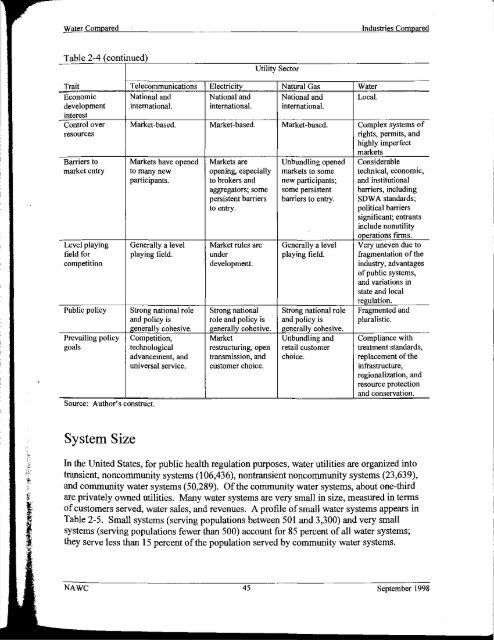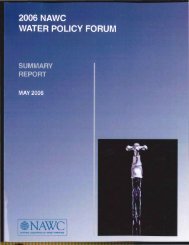BEECHER - NAWC
BEECHER - NAWC
BEECHER - NAWC
You also want an ePaper? Increase the reach of your titles
YUMPU automatically turns print PDFs into web optimized ePapers that Google loves.
Water ComparedIndustries ComparedTable 2-4 (continued)Utility SectorTrait Telecommunications Electricity Natural Gas WaterEconomic National and National and National and Local.development international. international. international.interestControl over Market-based. Market -based. Market-based. Complex systems ofresourcesrights, permits, andhighly imperfectmarketsBarriers to Markets have opened Markets are Unbundling opened Considerablemarket entry to many new opening, especially markets to some technical, economic,participants. to brokers and new participants; and institutionalaggregators; some some persistent barriers, includingpersistent barriers barriers to entry. SDW A standards;to entry.political barrierssignificant; entrantsinclude nonutilityoperations firms.Level playing Generally a level Market rules are Generally a level Very uneven due tofield for playing field. under playing field. fragmentation of thecompetition development. industry, advantagesof public systems,and variations instate and localregulation.Public policy Strong national role Strong national Strong national role Fragmented andand policy is role and policy is and policy is pluralistic.generally cohesive. generally cohesive. generally cohesive.Prevailing policy Competition, Market Unbundling and Compliance withgoals technological restructuring, open retail customer treatment standards,advancement, and transmission, and choice. replacement of theuniversal service. customer choice. infrastructure,regionalization, andresource protectionand conservation.,Source. Author s construct.System SizeIn the United States, for public health regulation purposes, water utilities are organized intotransient, noncommunity systems (106,436), nontransient noncommunity systems (23,639),and community water systems (50,289). Of the community water systems, about one-thirdare privately owned Utilities. Many water systems are very small in size, measured in termsof customers served, water sales, and revenues. A profile of small water systems appears inTable 2-5. Small systems (serving populations between 501 and 3,300) and very smallsystems (serving populations fewer than 500) account for 85 percent of all water systems;they serve less than 15 percent of the population served by community water systems.<strong>NAWC</strong> 45 September 1998
















